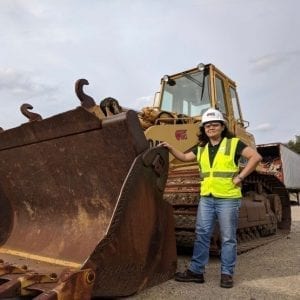How Women in Construction Positively Impact Profits and Collaboration
The construction workforce is evolving in many positive ways, especially as it actively embraces diversity and technology. Nevertheless, it remains one of the most male-dominated industries in the world. Out of the over 10 million construction workers in the US, just over one million are female. Even more unbalanced is when you look at the percentage of females in the construction trades; 3.9%.
In the trades, there is approximately one woman to every 20 men.
So, why the lack of women in construction? Undeniably, a career in construction offers plenty of opportunities and benefits. Still, there’s a long road ahead to balance the male to female ratio. While it’s easy to blame factors like lack of sufficient education and promotion from apprenticeship programs and universities to encourage women to enter the field, there’s not just one thing that contributes to the lack of females in the profession. Recruitment bias, company cultures where proactive conversations around harassment are not head, and even reasons as simple as tools and gear not made for women in mind, also all play a critical role in why more women aren’t considering building as a career. Nonetheless, if it takes a village to build up anything meaningful, likewise, it will take a comprehensive commitment from individuals, companies, non-profits, schools, and governments to truly balance the construction workforce for the better.
In addition to supporting gender equality from a human rights and diversity inclusion perspective, attracting and retaining more women in the construction workforce has major economic benefits. Numerous studies have come to a similar conclusion: gender diversity is good for business. In fact, according to the Peterson Institute, companies who were in the top 25% in gender diversity of their workforce were 46% more likely to outperform their industry average. In another survey from Credit Suisse, companies produced 10% higher cash flow returns, when women make up half of the senior managers.
Women in Construction Week is March 1-7, 2020, International Women’s Day is March 8, and Women’s History Month is happening this month. Nevertheless, the industry needs way more than just a day, week, or month to truly support and advance women in the field. Below, take a look (and share) our Women in Construction infographic, which includes the top statistics about females in the industry. Read on to also learn more context behind the figures and why promoting more women in construction should matter to builders and companies around the world.
Women in Construction: A Global Problem
Only 9.9% of women comprise the construction workforce in the US, and it is far from an individual country issue. In the UK, women only represent approximately 12.8% of the country’s construction workforce. In Canada, fewer women are even beginning their careers in construction–only 11% of women composing new apprenticeship training registrants in inter-provincially recognized Red Seal skilled trades. In Australia, since 12% of the construction workforce are women and leave the trade 39% faster than men, Sydney Morning Herald has cited it as “the last frontier for women at work.”
In some countries, the construction workforce gender balance is more equal. Nonetheless, other serious inequalities have not been addressed. For instance, in Cambodia, one in three construction workers are female. Despite doing the same hard work, these women are often paid around half of what their male counterparts make.
The Gender Pay Gap in Construction: A Deceptive Number
While the 99.1% US gender pay gap in construction is narrower than the nationwide average of approximately 81-82%, numbers can be deceiving. The truth is, women of color (as well as men of color) are more impacted by the pay gap when compared with their white male counterparts. This exists in practically all major industries, and construction is far from an exception. Just a few statistics to chew on:
- On average, black women earn $0.81 for every $1.00 paid to white, non-Hispanic men working as construction laborers.
- For Hispanic women in construction-related occupations, this pay gap is even greater, where they make 72.3% of Hispanic men’s and only 53.3% of white men’s earnings in the field.
In actuality, construction companies need to be more diligent about closing the pay gap not only by gender but also by addressing equal pay policies across also race, age, and education level. Without a commitment to level the playing field across all demographics, the gap will further discourage diverse talent from entering and benefiting the industry.
Promote and Prosper: A Need for More Women in Leadership Positions
The building industry has a great deal of improvement when it comes to supporting women in leadership positions. Although more women are needed at all job levels in construction, significant change is most likely to come from the top down. As mentioned above, more women in the workforce, especially in leadership and management positions, is beneficial for a company’s profits. Furthermore, a paper from the National Bureau of Economic Research also highlights that more women in leadership are helpful for a company’s overall collaboration because women are more likely to work cooperatively than men. As construction professionals already know, projects require a high-level of collaboration in order to be successful, and adding individuals with an affinity towards this type of communication can only improve your overall workforce productivity.
“Grandstanding about how important diversity is coupled with inaction on including women and minorities – especially in leadership roles – reinforces inequality. Create a culture where everyone is open to talking about tough topics, and people are held accountable for their words and actions. Everyone needs to be a part of the conversation to create change, not just women and minorities. Diverse leadership not only helps the company by benefiting from a wider range of ideas and talent, but also those in the company who can look up to them as role models.” – Kira Chase, Field Engineer, STV
Discouragingly, expectations for women in leadership, in general, are low. In fact, 1 in 4 Americans believes it’s more likely humans will colonize on Mars than that half of Fortune 500 CEOs will be women. However, while only around 13% of construction firms are women-owned, out of this small percentage, 9% of these firms achieve revenues of over $500,000 or more. When compared to the 8% of all firms achieving this threshold, it’s clear that women in leadership are making a huge impact on profitability for companies.
In a recent video and blog spotlight on Redshift, Nancy Juneau, CEO of Juneau Construction Company, “Women have the qualities that just lend themselves to be leaders in our industry.” Watch her powerful story:
Support Women in Construction Today
How do you support and encourage more women in construction? It’s a loaded question with many complexities and potential solutions. While there is no winning formula, just having more conversations around the issue is a critical place to start. Recently, we asked more than 25 women in construction their thoughts on how to build more equity in the industry. Read their powerful insights, here.
Furthermore, an active commitment to improving company culture and proactive recruitment efforts to attract recruit diverse talent are essential.
“The most important thing companies can do is to create and provide a culture that is positive, supportive, and encourages personal and company-wide success. Companies have to set and actively enforce a culture that encourages all employees to treat each other with care and respect and to support one another in a positive, constructive manner every single day. Once that culture is in place, a lot of the traditional beliefs and stereotypes commonly associated with the industry goes away.” – Syn Dee Chua, Assistant Project Manager, George J. Igel & Co., Inc.
In addition to highlighting some key efforts to bring more females to the industry, we also highlighted several of the top organizations and associations for women in construction in our infographic above. These professional organizations are great stepping stones for women looking to connect and leverage the efforts of others in the field. Furthermore, industry-events like Groundbreaking Women in Construction, Women in Construction Summit, and NAWIC Annual Conference are also important podiums to support and amplify female voices in the industry.
If you’re looking to read more about inspirational women in construction, this month, Autodesk Construction Solutions will be sharing stories of powerful women in construction on this blog and across Facebook, LinkedIn, Twitter, and Instagram. We encourage you to comment and share your stories.
And lastly, amplifying our voices together ultimately builds a better industry. Share this post and infographic by clicking the social icons below (or above).






Responses